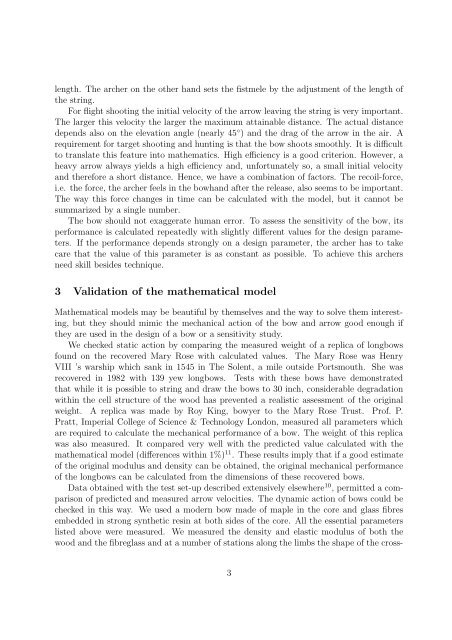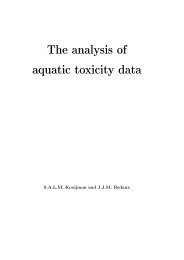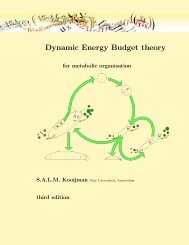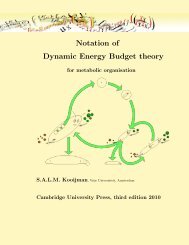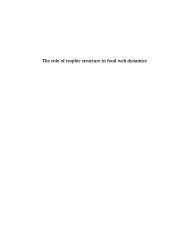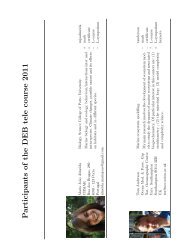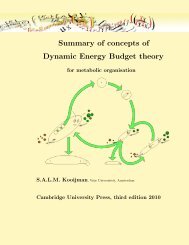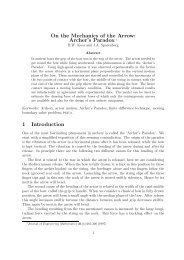Archery and Mathematical Modelling 1
Archery and Mathematical Modelling 1
Archery and Mathematical Modelling 1
Create successful ePaper yourself
Turn your PDF publications into a flip-book with our unique Google optimized e-Paper software.
length. The archer on the other h<strong>and</strong> sets the fistmele by the adjustment of the length ofthe string.For flight shooting the initial velocity of the arrow leaving the string is very important.The larger this velocity the larger the maximum attainable distance. The actual distancedepends also on the elevation angle (nearly 45 ◦ ) <strong>and</strong> the drag of the arrow in the air. Arequirement for target shooting <strong>and</strong> hunting is that the bow shoots smoothly. It is difficultto translate this feature into mathematics. High efficiency is a good criterion. However, aheavy arrow always yields a high efficiency <strong>and</strong>, unfortunately so, a small initial velocity<strong>and</strong> therefore a short distance. Hence, we have a combination of factors. The recoil-force,i.e. the force, the archer feels in the bowh<strong>and</strong> after the release, also seems to be important.The way this force changes in time can be calculated with the model, but it cannot besummarized by a single number.The bow should not exaggerate human error. To assess the sensitivity of the bow, itsperformance is calculated repeatedly with slightly different values for the design parameters.If the performance depends strongly on a design parameter, the archer has to takecare that the value of this parameter is as constant as possible. To achieve this archersneed skill besides technique.3 Validation of the mathematical model<strong>Mathematical</strong> models may be beautiful by themselves <strong>and</strong> the way to solve them interesting,but they should mimic the mechanical action of the bow <strong>and</strong> arrow good enough ifthey are used in the design of a bow or a sensitivity study.We checked static action by comparing the measured weight of a replica of longbowsfound on the recovered Mary Rose with calculated values. The Mary Rose was HenryVIII ’s warship which sank in 1545 in The Solent, a mile outside Portsmouth. She wasrecovered in 1982 with 139 yew longbows. Tests with these bows have demonstratedthat while it is possible to string <strong>and</strong> draw the bows to 30 inch, considerable degradationwithin the cell structure of the wood has prevented a realistic assessment of the originalweight. A replica was made by Roy King, bowyer to the Mary Rose Trust. Prof. P.Pratt, Imperial College of Science & Technology London, measured all parameters whichare required to calculate the mechanical performance of a bow. The weight of this replicawas also measured. It compared very well with the predicted value calculated with themathematical model (differences within 1%) 11 . These results imply that if a good estimateof the original modulus <strong>and</strong> density can be obtained, the original mechanical performanceof the longbows can be calculated from the dimensions of these recovered bows.Data obtained with the test set-up described extensively elsewhere 10 , permitted a comparisonof predicted <strong>and</strong> measured arrow velocities. The dynamic action of bows could bechecked in this way. We used a modern bow made of maple in the core <strong>and</strong> glass fibresembedded in strong synthetic resin at both sides of the core. All the essential parameterslisted above were measured. We measured the density <strong>and</strong> elastic modulus of both thewood <strong>and</strong> the fibreglass <strong>and</strong> at a number of stations along the limbs the shape of the cross-3


